Sidonia
this wiki

Sidonia
The planet Sidonia was located in the Sinam system. A Class H planet, Sidonia was thought by most Federation scientists to be uninhabited as late as the early 23rd century due to its unusual atmosphere (containing an extremely rare gaseous compound of Bilitrium, normally a crystalline element but highly explosive in all forms) and proximity to the late-stage Sinam star, which made the planet arid and its atmosphere toxic to most lifeforms. However, it was home to a humanoid species that had evolved from creatures similar to Terran lizards. For much of its history, most work activity on Sidonia consisted of water mining, farming of animals and sparse vegetation, and hunting; however, by the 22nd century they had evolved to an industrial society, developing coal-based machines for manufacturing, mining and travel. Science also took a large leap in 2115 when the nascent science community built communication devices capable of broadcasting and recieving messages. They also warned of the correlation between the accelerating death process of the Sinam star and the increasing drought and heat plaguing the planet.
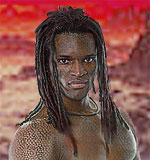
Lauan man
Biological Life on Sidonia
Native humanoid Sidonians originally consisted of eight distinctly different races, although only four survived once the Northern Hemisphere was destroyed by the Flare Crisis (see below). Current extant races are the Ta, Ne, Lau and Bak, notable differences among them being the type and extent of scale coverage, skin tone, scale coloring, height and length of limbs. The most populous are the Ne people, who were better positioned to survive the Crisis due to optimal location in the Southern Hemisphere's Veian region. Their culture has also traditionally put more emphasis on scientific study, which has greatly added to their society's quality of life.
Like all Sidonians, the Ne have some reptilian features: in addition to being semi-chameleonic (able to change their usually dark brown skin tone to match the local desert environment), they are covered by smooth silver-green scales, normally just visible around their eyes, edges of the forehead and body (mostly upper arms and legs). When necessary, either by conscious decision or instinct, the scales emerge to cover all or part of their bodies, providing limited protection against blades and sharp hazards such as horns, claws, and teeth. There is some modest protection against blunt objects or falls.
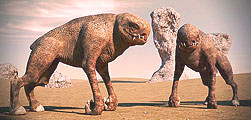
Sidonian Wolves, aka Dezorai
The prime non-humanoids on the planet represent threats to the humanoid Sidonians' survival, including the two biggest predators: venom beasts, carapace-covered hominids that spit a deadly venom to paralyze prey (which is then eaten alive); and dezorai (singular: dezora), four-legged creatures that hunt in packs like Terran wolves, but with the common reptilian scales suitable to the Sidonian climate. The Venom Beasts are wilier and often attack Sidonian settlements, while the Dezorai are themselves used by both the Sidonian humanoids and the Venom Beasts for food if successfully caught--a difficult task given their astonishing speed.
Culture on Sidonia
Names in the Sidonian culture traditionally have several components. For example, the name of one of Sidonia's most famous current scientist-inventors, Ve'ne'ko'tav'onn, can be loosely translated as "Of the region of Ve, the ethnicity of Ne, a son of the honored clan of Ko [a noted political and military leader about 750 years ago], personally named Tav, of the family Onn." Family and friends would call him "Tav," while more formally he would be known by his last name, preceded by "Gen" (similar to "Mr.") or--since he is a scientist--"Adin" (similar to "Doctor"). For a women, these titles would be "Gen'ai and "Adin'ai."
(See also Religion, below.)
Environmental Disaster: The Flare Crisis
By 2085 (note: dates are approximate as they do not correlate well to Stardate format), Sinam had grown more unstable. The planet's water supply was rapidly dwindling and increased solar radiation took its toll on planet life. That year, a solar flare ignited a substantial portion of the Bilitrium-laced atmosphere and made all land on the Northern hemisphere (which is tilted toward the sun) instantly uninhabitable, killing hundreds of thousands; even on the Southern hemisphere, deaths from dehydration and radiation exposure increased exponentially, and fetus/infant mortality threatened the population's future. The research scientists who had warned of the impending disaster were proven correct, and Sidonians knew they were in danger of extinction.
Post-Flare Crisis
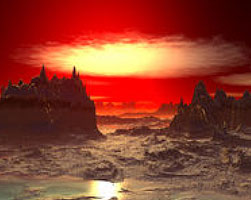
Sidonian Southern Hemisphere, c. 2096
Swiftly regional governments were given mandates to enact whatever laws were deemed necessary to ensure survival of the species. New focus was placed on maintaining the population level (see below, "Propagation Act"), rationing food and water, and encouraging scientific/technological advances to extract as much water as possible from the hidden depths of the planet, removing toxins from surviving flora in order to provide new means of nutrition, and determining whether saving Sidonia was even feasible--or if abandoning their longtime homeland was an inevitability.
Many scientists believed the planet was doomed, and turned to interplanetary communication and travel as the best answers to finding a new habitable home within their system. Some inventors, led for generations by the influential Onn family (currently headed by husband Tav--full name: Ve'ne'ko'tav'onn--and prime wife Ayul--full name: Ve'ne'sa'ayul'onn), developed airships better capable of withstanding the toxicity and deadly heat of the upper atmosphere; these were intended to encourage development of rain through cloud seeding.
The Propagation Act and Sidonian Society
One of the most controversial decisions taken by planetary leaders post-Flare was the Propagation Act of 2100, an initiative endorsed by all the surviving regions' governing bodies--which normally did not cooperate with one another. The Propagation Act attempted to stem the dwindling population through strictly regulated procreation practices. Male and female Sidonians were encouraged to reproduce as early and often as possible. Birth control became illegal, as was terminating a pregnancy for any reason other than the imminent death of the mother.
Sidonians were strongly discouraged from monagomous relationships. While marriage was still allowed, existing husbands and wives were now required to register with their local magistrate in order to arrange for additional breeding partners, who were matched in order to create the strongest genetic issue. Polygyny was more common than Polyandry, particularly because female Sidonians had an eight-month gestation period in which mating was unproductive. Husbands had as many as four wives, although the first wife--the Prime--was granted both more legal rights as well as (culturally) more honor/prestige, as were any children born of a married pair.
Meanwhile, parents controlled and bartered their children's reproductive rights, with sons and daughters contracted to their future breeding partners long before they knew one another. As soon as sexual maturity was reached (at or around age 11), mating with their exclusive contracted partners began. Such contracts usually lasted only four months; if conception did not take place, the contract was voided and both parties were shifted to the next match on their parents' list as soon as possible. If, however, a young girl became pregnant earlier than the contract required, an extra price was paid by the father's family, and the young man was moved on to his next scheduled partner.
The most prolific girls/women gave birth to as many as 15 children before age 30, at which point ill health and malnutrition made them poor prospects for motherhood. Similarly, due to the increasing effects of solar radiation, men were usually sterile by age 40; by that age some men had fathered dozens of children. However, since fetal, infant and child mortality rates remained high, the Sidonians' overall population figures remained stable, rather than increasing.
Outreach to the rest of the Sinam system and the Federation
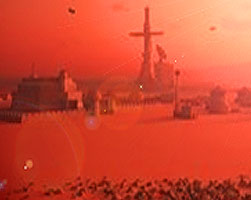
Ijarin, the capital of the Ve Region, 2242
Communication with other local planets in the Sinam system was achieved in the late 22nd century, but the first attempts to travel to their neighbors were disastrous. Due to the extraordinarily dangerous radiation and easily-ignited gases within the upper atmosphere, the nearest planets refused to send ships to Sidonia, while outgoing exploration took decades to achieve without mortality. It was at this time that astroscientists sent out unmanned beacons to call for help, desperate for assistance. After nearly a century, one of these beacons reached a Federation ship, the USS Osaka, and thanks to the message's mathematic code, images and basic pictograms, the ship's crew were able to identify this as a distress signal. Despite Sidonia's lack of a warp-capable society, the Osaka responded, using the Linguacode created for such situations. After First Contact was deemed successful, the Federation became instrumental in mediating negotations between Sidonia and its neighbors in the system so that Sidonians could find new homes on the two planets nearest them--the only ones in the system with atmospheres that had traces of Bilitrium and thus were semi-compatible with Sidonian biology. Scientists down on Sidonia, again led by Tav and Ayul Onn, developed a special air processing filter for Sidonian emigrants to utilize as much Bilitrium as possible while living on these other planets.
This began a stream of emigration that became known as the Great Flight, which put even more pressure on Sidonians to ensure the continuation of their race. The Propagation Act broadened to ensure that male Sidonians who were leaving the planet took precedence over females when it came to custody of children. To ensure that Sidonian children survived and escaped the planet with their fathers, community creches were built and became mandatory for all Sidonian infants whose mothers were remaining planetside. Babies were taken from mothers at birth, raised by their fathers' families as well as special nurses trained for this purpose. Once the children were old enough to thrive, their fathers brought them to their new home planet. Mothers rarely, if ever, saw their children again.
The Diaspora
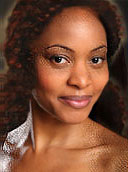
Ve'ne'ko'nia'onn, the first Sidonian in Starfleet
Sidonians on other planets in the Sinam system attempted to remain closely connected with one another to maintain their culture. The population still grew diffuse due to immigration laws that mandated only a certain number of these not-very-welcome sub-citizens were allowed within various principalities. Eventually even these numbers grew too many, and both neighbor planets limited immigration sharply. Sidonians were treated poorly and kept in inhospitable areas, their movements sharply regulated.
Once again the Federation stepped in to mediate, but their efforts were not as successful this time. Both the remaining population on Sidonia and the neighbor planets were unable to negotiate a workable solution to the problem. Federation scientists worked with Sidonians to make their home planet more hospitable in an attempt to lengthen Sidonia's expected lifespan, with cloud seeding efforts semi-successful. However, most Sidonians had learned of ill-treatment of their diaspora by the other planets and grew wary of outsiders.
The Onns continued to work on solutions to the breathing problem, and in 2256 they developed a concentrated respirator that would better enable Sidonians to expand their horizons to Class M planets by allowing them to go 48 hours before needing to have their cells replenished with the Bilitrium compound. The first person to use this new device was their daughter, Nia Onn (Ve'ne'ko'nia'onn), who as a gesture of good faith and in hopes of helping her people survive, tested the risky breathing apparatus by leaving her planet to join Starfleet Academy, the Federation having waived the necessity of becoming a citizen of the Federation in order to do so.
Starfleet Medical Supplemental Biological Study
Starfleet Medical notes that while the above filtration and respiration technology has sufficed in the short term, since so few Sidonian lifeforms have ventured beyond their Class H atmosphere, little research has been completed on long-term survival exclusive of their optimal living conditions. Based on examination and study of the sole Sidonian member of Starfleet (with her permission), the ability to breathe standard Class M planet air has not significantly improved over a ten-year period (at time of this writing). Survival remains predicated on administration of the aforementioned synthesized lower-level Bilitrium-based compound (Bilitrium Nitrogen Dioxide, aka BuNO2). Eight-hour sessions inhaling this supplment via a mask and respirator must be taken every 48 - 56 hours. Delaying or withholding this treatment for longer will result in hypobilitremia (Bilitrium-breathing organisms' equivalent to hypoxemia, i.e., low level of oxygen in blood). Through this regular schedule of alternate nocturnal sessions, Bilitrium blood concentration averages at 92%, which keeps the subject in suitably healthy fitness level. At 90%, only the mildest impairment (mostly related to stamina) is noticeable..At lower concentrations, breathing difficulty, dizziness and some vision issues may ensue. If the Bu level drops to 75% or below, patient will be considered in hypobilitria--the equivalent to hypoxia (low level of oxygen in tissues). Symptoms may include breathlessness, tunnel vision, nausea, hallucinations, dizziness, rapid pulse, peripheral numbness, and chills, and will likely be followed by ataxia, loss of cognitive function, paralysis, dehydration, low blood pressure, and organ failure. It is speculated (through tests with sample non-sapient Sidonian lifeforms) that beyond this point, without treatment with pure Bilitrium, patients will fall into a coma-like state similar to hibernation, followed by death.
Status with the Federation
Sidonia has not yet applied for membership with the Federation. It has been considered an unlikely candidate due to its incompatibility with the requirements of Federation membership, from lacking faster-than-light travel to its majority culture's societal system that by most Federation standards subjugates women and children to an intolerable degree.
Religious culture
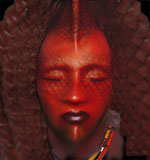
Ceremonial mask depicting Sid'Os, c. 2120
By far the most popular religion is the worship of Sid'Os, believed to be the High Goddess of the race. The pantheon of Sid'Os and her lovers/offspring are worshipped as lesser deities as well. The dire situation of the planet is currently blamed on an internecine battle for power among the pantheon, specifically between Sid'Os and her daughter Sid'Ren'Tai (called "Ren," the goddess of water and the planet's flora and crops). The conflict primarily surrounds Ren's envy of her sister, her favoritism toward her own daughter, and the attempted murder of her sister's child. When punished by Sid'Os, Sid'Ren'Tai spitefully withheld her life-giving tears (rain) to the planet, creating the current drought.
Members of the pantheon include:
- Sid'Os: High goddess of the Sidonian, shown as strong woman, mother of the race, all Sidonians are from her, and return to her at death.
- Seht'Dar: Created by Sid'Os from air ("Dar" in Sidonian) to become her daughter's mate. He is the god of the night sky, giver of peace and rest, and the sole primary deity with only Sid'Os as a parent.
- Sid'Ren'Tai ("Ren"): Daughter and firstborn of Sid'Os, born after Sid'Os mated with the spirit of a comet ("Tai" in Sidonian). Goddess of water and plants; she who bought forth life-giving crops to the planet.
- Sid'Maj'Aqa ("Maj"): Son of Sid'Os, born after Sid'Os mated with the spirit of the earth ("Aqa" in Sidonian). God of the home and protection. A blessing in his name means the guest is welcome in a Sidonian's house.
- Sid'Lia'Oro ("Lia"): Second daughter of Sid'Os, who mated with the spirit of a bird (the Oro, similar to a Terran falcon). Goddess of fecundity, a very popular deity currently on Sidonia. Lia and Seht'Dar were attracted to one another but their union was not Sid'Os's plan--Seht'Dar was intended for Lia's sister, Ren. The sisters became enemies, and a similar rivalry between both sisters' children.
- Ren'Sala'Seht ("Sala"): only daughter of Ren and Seht'Dar. Originally guardian of animal life, she eventually became the goddess of death responsible for gathering souls to Sid'Os. Despite her friendship and love for her cousin Lia'Nel'Seht, their parents have turned them into rivals.
- Lia'Nel'Seht ("Nel"): only daughter of Lia and Seht'Dar. Goddess of healing/renewal. Imprisoned and lamed by Sid'Ren'Tai out of jealousy, and unable to heal herself. Unwiling rival of her cousin Sala.
- Nel'Sen'Maj ("Sen"): Son of cousins Maj and Nel. God of travel and navigation, of finding a way safely home. Sidonians pray that Sen will lead them on their journeys to new lands, and eventually help them find their way back to one another for the Great Reunion at the end of time.
